Marks & Spencer: HR Value & Contribution to Success Report
VerifiedAdded on 2021/02/20
|13
|3297
|19
Report
AI Summary
This report analyzes the value and contribution of Human Resources to organizational success, using Marks & Spencer (M&S) as a case study. The report begins with an introduction to M&S, its business model, and its functional organizational structure. It then explores the relationship between organizational design and structure, highlighting how M&S utilizes its functional structure. The report delves into various HR approaches, including motivation techniques like Maslow's and Adam's Equity Theory, human capital theory, and knowledge management through organizational learning. It evaluates the impact of these approaches on employee engagement and performance. The report also discusses emerging HR developments like automation and learning management systems. Finally, it concludes by emphasizing the importance of HR in driving sustainable performance and adapting to changes in the internal and external environment, offering recommendations for M&S to further enhance its HR practices. The report is divided into two parts, with the second part covered in a poster presentation format.
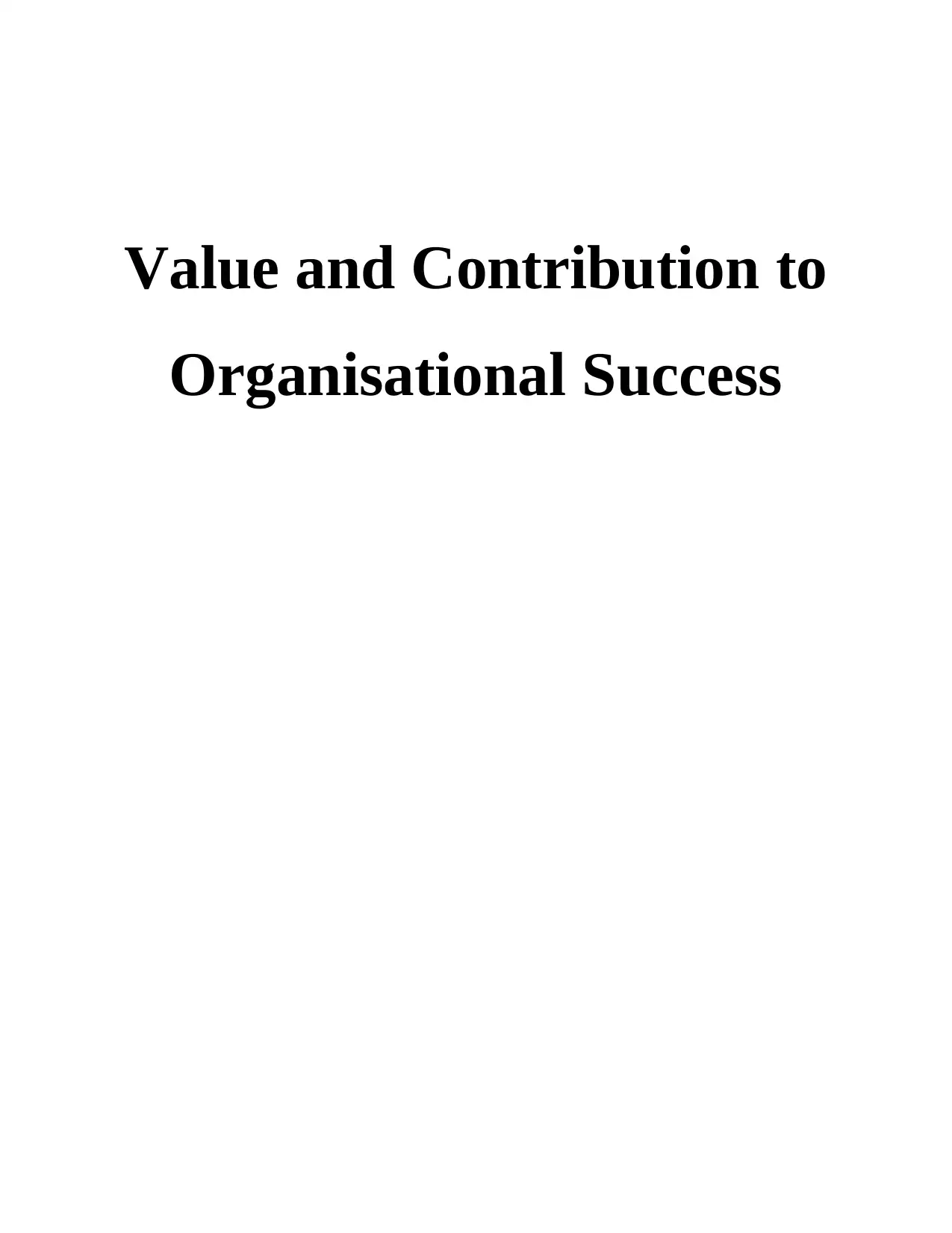
Value and Contribution to
Organisational Success
Organisational Success
Paraphrase This Document
Need a fresh take? Get an instant paraphrase of this document with our AI Paraphraser
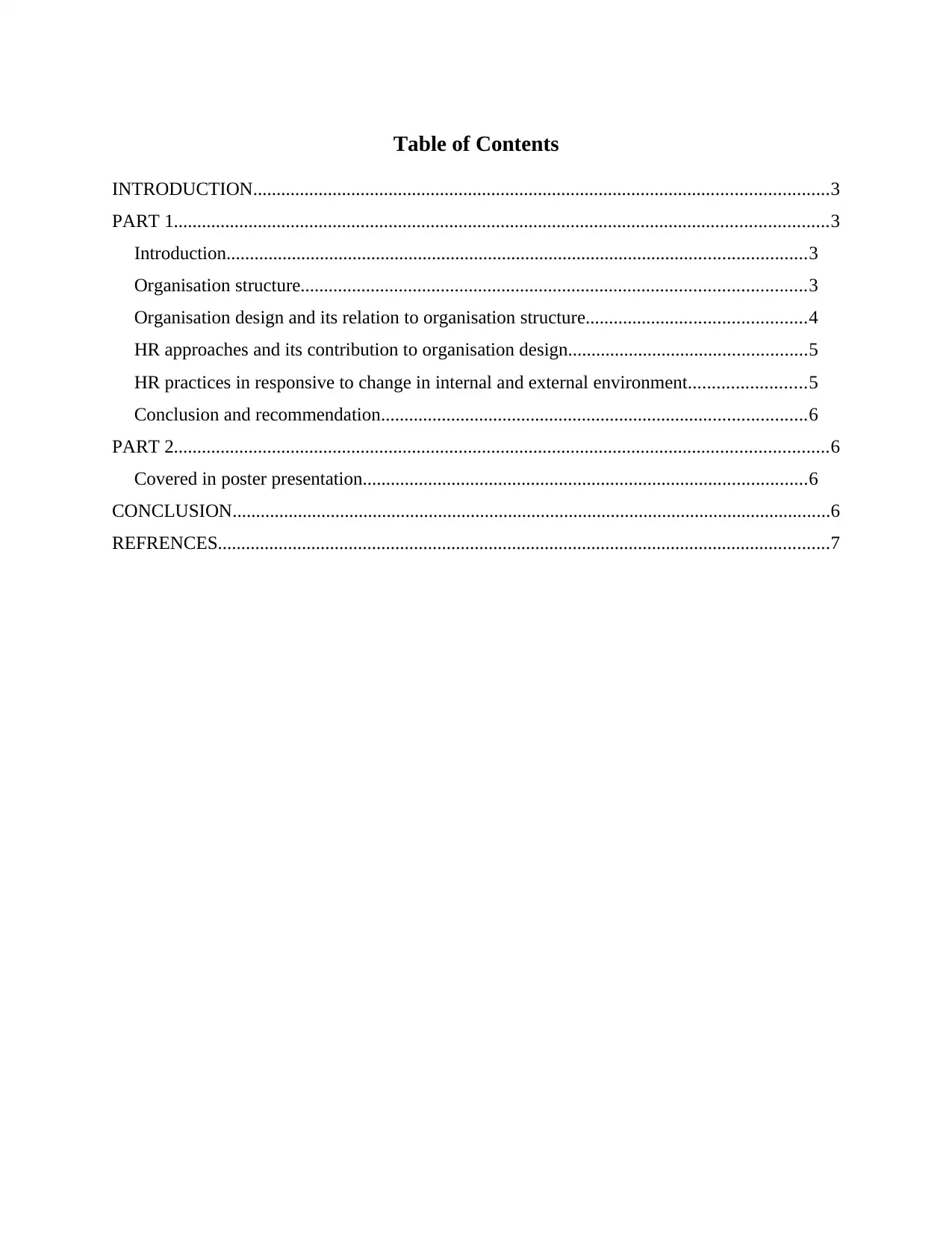
Table of Contents
INTRODUCTION...........................................................................................................................3
PART 1............................................................................................................................................3
Introduction............................................................................................................................3
Organisation structure............................................................................................................3
Organisation design and its relation to organisation structure...............................................4
HR approaches and its contribution to organisation design...................................................5
HR practices in responsive to change in internal and external environment.........................5
Conclusion and recommendation...........................................................................................6
PART 2............................................................................................................................................6
Covered in poster presentation...............................................................................................6
CONCLUSION................................................................................................................................6
REFRENCES...................................................................................................................................7
INTRODUCTION...........................................................................................................................3
PART 1............................................................................................................................................3
Introduction............................................................................................................................3
Organisation structure............................................................................................................3
Organisation design and its relation to organisation structure...............................................4
HR approaches and its contribution to organisation design...................................................5
HR practices in responsive to change in internal and external environment.........................5
Conclusion and recommendation...........................................................................................6
PART 2............................................................................................................................................6
Covered in poster presentation...............................................................................................6
CONCLUSION................................................................................................................................6
REFRENCES...................................................................................................................................7
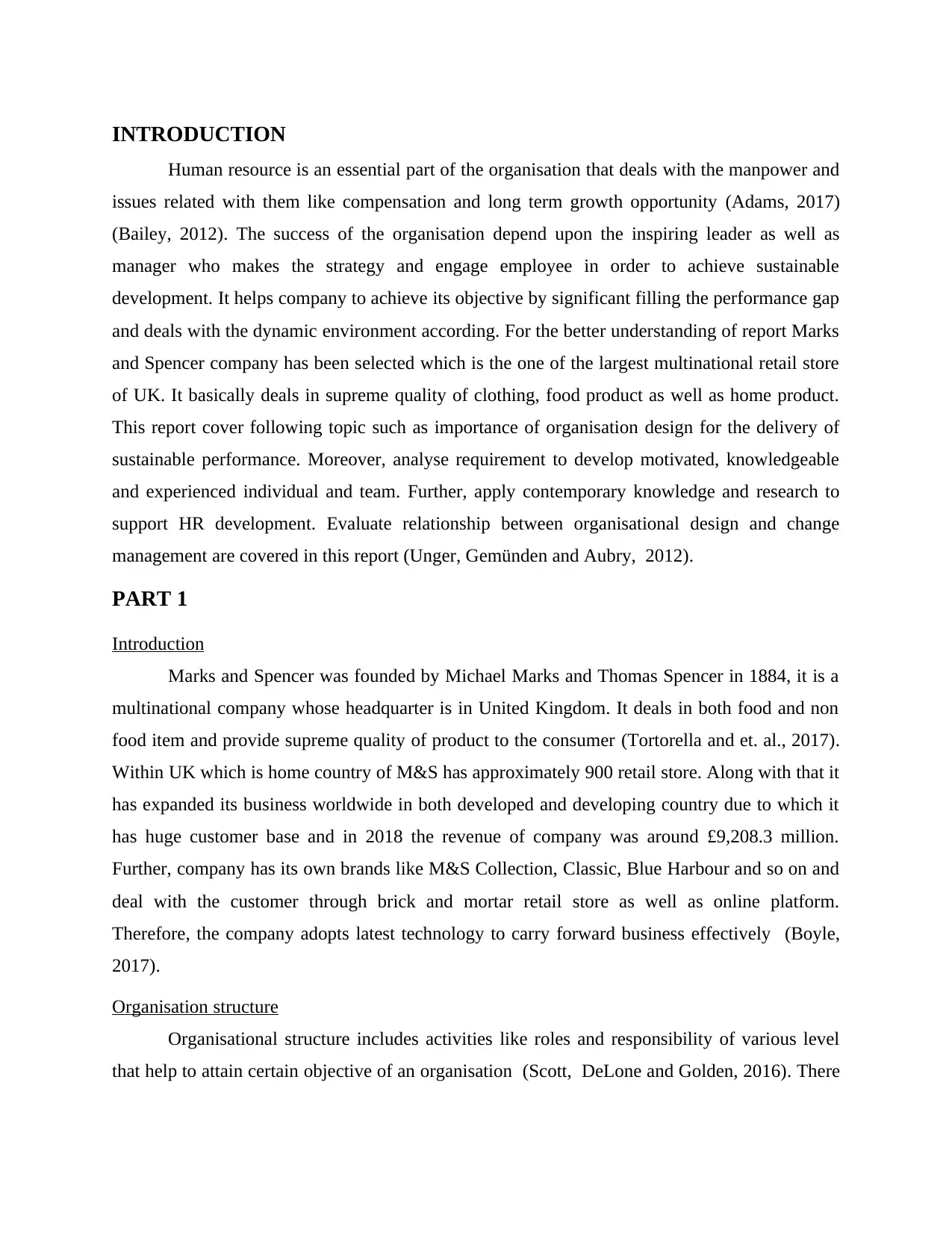
INTRODUCTION
Human resource is an essential part of the organisation that deals with the manpower and
issues related with them like compensation and long term growth opportunity (Adams, 2017)
(Bailey, 2012). The success of the organisation depend upon the inspiring leader as well as
manager who makes the strategy and engage employee in order to achieve sustainable
development. It helps company to achieve its objective by significant filling the performance gap
and deals with the dynamic environment according. For the better understanding of report Marks
and Spencer company has been selected which is the one of the largest multinational retail store
of UK. It basically deals in supreme quality of clothing, food product as well as home product.
This report cover following topic such as importance of organisation design for the delivery of
sustainable performance. Moreover, analyse requirement to develop motivated, knowledgeable
and experienced individual and team. Further, apply contemporary knowledge and research to
support HR development. Evaluate relationship between organisational design and change
management are covered in this report (Unger, Gemünden and Aubry, 2012).
PART 1
Introduction
Marks and Spencer was founded by Michael Marks and Thomas Spencer in 1884, it is a
multinational company whose headquarter is in United Kingdom. It deals in both food and non
food item and provide supreme quality of product to the consumer (Tortorella and et. al., 2017).
Within UK which is home country of M&S has approximately 900 retail store. Along with that it
has expanded its business worldwide in both developed and developing country due to which it
has huge customer base and in 2018 the revenue of company was around £9,208.3 million.
Further, company has its own brands like M&S Collection, Classic, Blue Harbour and so on and
deal with the customer through brick and mortar retail store as well as online platform.
Therefore, the company adopts latest technology to carry forward business effectively (Boyle,
2017).
Organisation structure
Organisational structure includes activities like roles and responsibility of various level
that help to attain certain objective of an organisation (Scott, DeLone and Golden, 2016). There
Human resource is an essential part of the organisation that deals with the manpower and
issues related with them like compensation and long term growth opportunity (Adams, 2017)
(Bailey, 2012). The success of the organisation depend upon the inspiring leader as well as
manager who makes the strategy and engage employee in order to achieve sustainable
development. It helps company to achieve its objective by significant filling the performance gap
and deals with the dynamic environment according. For the better understanding of report Marks
and Spencer company has been selected which is the one of the largest multinational retail store
of UK. It basically deals in supreme quality of clothing, food product as well as home product.
This report cover following topic such as importance of organisation design for the delivery of
sustainable performance. Moreover, analyse requirement to develop motivated, knowledgeable
and experienced individual and team. Further, apply contemporary knowledge and research to
support HR development. Evaluate relationship between organisational design and change
management are covered in this report (Unger, Gemünden and Aubry, 2012).
PART 1
Introduction
Marks and Spencer was founded by Michael Marks and Thomas Spencer in 1884, it is a
multinational company whose headquarter is in United Kingdom. It deals in both food and non
food item and provide supreme quality of product to the consumer (Tortorella and et. al., 2017).
Within UK which is home country of M&S has approximately 900 retail store. Along with that it
has expanded its business worldwide in both developed and developing country due to which it
has huge customer base and in 2018 the revenue of company was around £9,208.3 million.
Further, company has its own brands like M&S Collection, Classic, Blue Harbour and so on and
deal with the customer through brick and mortar retail store as well as online platform.
Therefore, the company adopts latest technology to carry forward business effectively (Boyle,
2017).
Organisation structure
Organisational structure includes activities like roles and responsibility of various level
that help to attain certain objective of an organisation (Scott, DeLone and Golden, 2016). There
⊘ This is a preview!⊘
Do you want full access?
Subscribe today to unlock all pages.

Trusted by 1+ million students worldwide

are various types of organisational structure such as hierarchical, matrix, divisional structure and
so on among them Marks and Spencer has adopted functional structure.
Functional structure: It is one of the most efficient structures in which employees
perform the role based on same specialisation or similar type of skill set. It include various
division which are supervised by functional manager who have expertise knowledge over their
subjects (Chang and et. al., 2013). The role of functional manager within M&S is to utilise the
effort of employee or team member to attain the objective of whole function successfully. The
whole authority whether it is related to decision making or allocate of resources or budget recites
in hand of functional manager. The main benefit which respective company gets of using
functional structure is that each and every employee of company are grouped based on the same
knowledge and interest which helps in experiencing high quality output. Along with that it helps
to avoid duplicate work and leads to better accountability of work.
Organisation design and its relation to organisation structure
Organisation design helps in the integration of information, workforce as well as
technology at right mix to attain the objective successfully. Organisation structure on the other
way is a formal process of communication, authority or power that define the role role of an
employee (Guldberg and et. al., 2013). In context to Marks and Spencer company which can use
functional organisation structure as it promote employee to come up with innovative idea and
uses advance technology to produce the desirable output. Along with that it does not involve the
role of top management as each division has its manager that handle decision making process
effectively. Hence adequate relationship between organisation design as well as structure helps
to maintain balance in term of employee and employer relation and proper delegation of
authority. Therefore, there are some of the points based on which both design and structure are
interrelated to each other.
Organisation size: M&S being large organisation involve the huge number of employees
for which functional structure can be adopted so that each level is designed with multiple level of
authority. Moreover, in terms of design employees of same skill are categorised together but they
have low decision making power (Rodríguez-Sánchez and Vera Perea, 2015). Hence, to maintain
the connectivity and communication among employer and employee functional manager plays an
efficient role.
so on among them Marks and Spencer has adopted functional structure.
Functional structure: It is one of the most efficient structures in which employees
perform the role based on same specialisation or similar type of skill set. It include various
division which are supervised by functional manager who have expertise knowledge over their
subjects (Chang and et. al., 2013). The role of functional manager within M&S is to utilise the
effort of employee or team member to attain the objective of whole function successfully. The
whole authority whether it is related to decision making or allocate of resources or budget recites
in hand of functional manager. The main benefit which respective company gets of using
functional structure is that each and every employee of company are grouped based on the same
knowledge and interest which helps in experiencing high quality output. Along with that it helps
to avoid duplicate work and leads to better accountability of work.
Organisation design and its relation to organisation structure
Organisation design helps in the integration of information, workforce as well as
technology at right mix to attain the objective successfully. Organisation structure on the other
way is a formal process of communication, authority or power that define the role role of an
employee (Guldberg and et. al., 2013). In context to Marks and Spencer company which can use
functional organisation structure as it promote employee to come up with innovative idea and
uses advance technology to produce the desirable output. Along with that it does not involve the
role of top management as each division has its manager that handle decision making process
effectively. Hence adequate relationship between organisation design as well as structure helps
to maintain balance in term of employee and employer relation and proper delegation of
authority. Therefore, there are some of the points based on which both design and structure are
interrelated to each other.
Organisation size: M&S being large organisation involve the huge number of employees
for which functional structure can be adopted so that each level is designed with multiple level of
authority. Moreover, in terms of design employees of same skill are categorised together but they
have low decision making power (Rodríguez-Sánchez and Vera Perea, 2015). Hence, to maintain
the connectivity and communication among employer and employee functional manager plays an
efficient role.
Paraphrase This Document
Need a fresh take? Get an instant paraphrase of this document with our AI Paraphraser
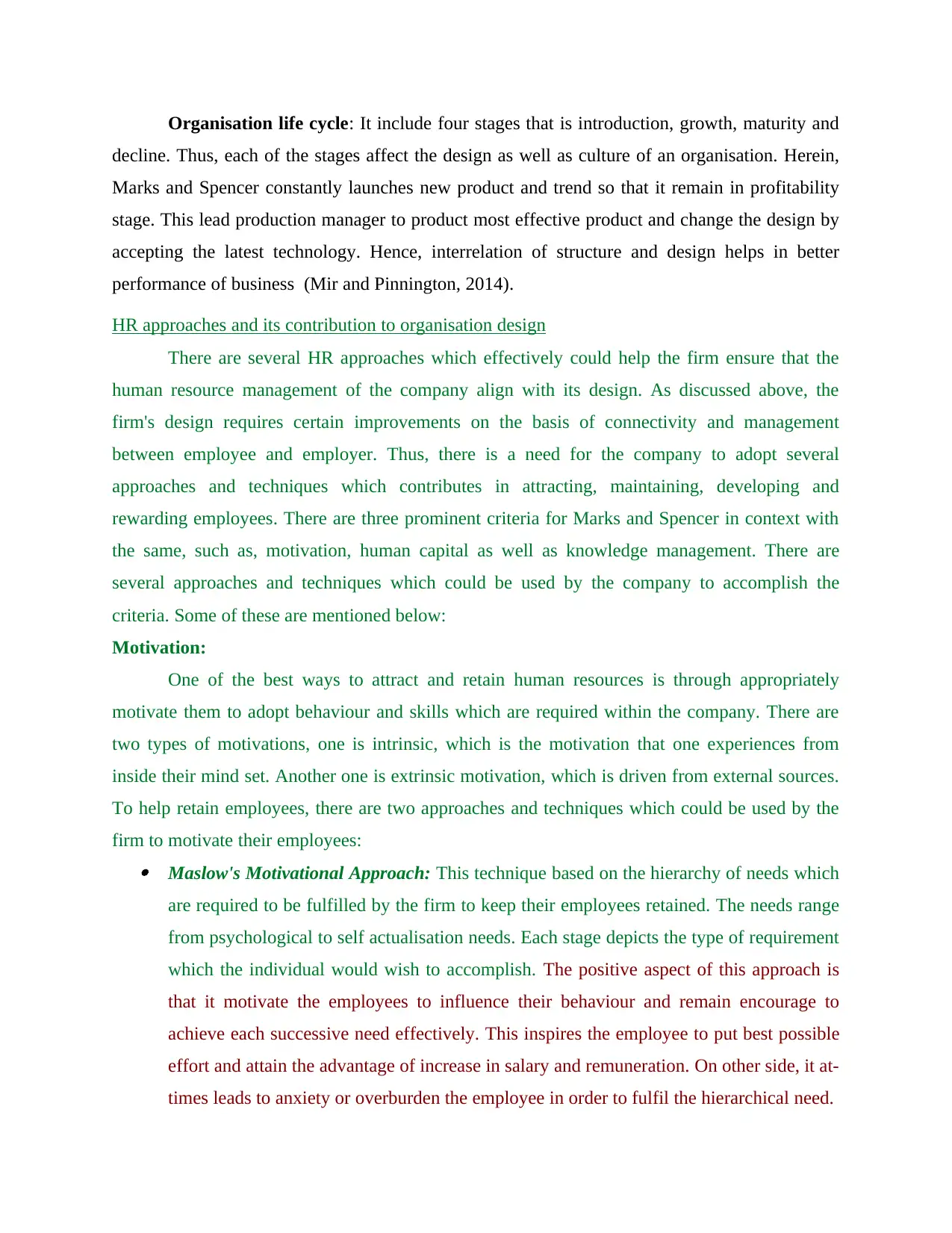
Organisation life cycle: It include four stages that is introduction, growth, maturity and
decline. Thus, each of the stages affect the design as well as culture of an organisation. Herein,
Marks and Spencer constantly launches new product and trend so that it remain in profitability
stage. This lead production manager to product most effective product and change the design by
accepting the latest technology. Hence, interrelation of structure and design helps in better
performance of business (Mir and Pinnington, 2014).
HR approaches and its contribution to organisation design
There are several HR approaches which effectively could help the firm ensure that the
human resource management of the company align with its design. As discussed above, the
firm's design requires certain improvements on the basis of connectivity and management
between employee and employer. Thus, there is a need for the company to adopt several
approaches and techniques which contributes in attracting, maintaining, developing and
rewarding employees. There are three prominent criteria for Marks and Spencer in context with
the same, such as, motivation, human capital as well as knowledge management. There are
several approaches and techniques which could be used by the company to accomplish the
criteria. Some of these are mentioned below:
Motivation:
One of the best ways to attract and retain human resources is through appropriately
motivate them to adopt behaviour and skills which are required within the company. There are
two types of motivations, one is intrinsic, which is the motivation that one experiences from
inside their mind set. Another one is extrinsic motivation, which is driven from external sources.
To help retain employees, there are two approaches and techniques which could be used by the
firm to motivate their employees: Maslow's Motivational Approach: This technique based on the hierarchy of needs which
are required to be fulfilled by the firm to keep their employees retained. The needs range
from psychological to self actualisation needs. Each stage depicts the type of requirement
which the individual would wish to accomplish. The positive aspect of this approach is
that it motivate the employees to influence their behaviour and remain encourage to
achieve each successive need effectively. This inspires the employee to put best possible
effort and attain the advantage of increase in salary and remuneration. On other side, it at-
times leads to anxiety or overburden the employee in order to fulfil the hierarchical need.
decline. Thus, each of the stages affect the design as well as culture of an organisation. Herein,
Marks and Spencer constantly launches new product and trend so that it remain in profitability
stage. This lead production manager to product most effective product and change the design by
accepting the latest technology. Hence, interrelation of structure and design helps in better
performance of business (Mir and Pinnington, 2014).
HR approaches and its contribution to organisation design
There are several HR approaches which effectively could help the firm ensure that the
human resource management of the company align with its design. As discussed above, the
firm's design requires certain improvements on the basis of connectivity and management
between employee and employer. Thus, there is a need for the company to adopt several
approaches and techniques which contributes in attracting, maintaining, developing and
rewarding employees. There are three prominent criteria for Marks and Spencer in context with
the same, such as, motivation, human capital as well as knowledge management. There are
several approaches and techniques which could be used by the company to accomplish the
criteria. Some of these are mentioned below:
Motivation:
One of the best ways to attract and retain human resources is through appropriately
motivate them to adopt behaviour and skills which are required within the company. There are
two types of motivations, one is intrinsic, which is the motivation that one experiences from
inside their mind set. Another one is extrinsic motivation, which is driven from external sources.
To help retain employees, there are two approaches and techniques which could be used by the
firm to motivate their employees: Maslow's Motivational Approach: This technique based on the hierarchy of needs which
are required to be fulfilled by the firm to keep their employees retained. The needs range
from psychological to self actualisation needs. Each stage depicts the type of requirement
which the individual would wish to accomplish. The positive aspect of this approach is
that it motivate the employees to influence their behaviour and remain encourage to
achieve each successive need effectively. This inspires the employee to put best possible
effort and attain the advantage of increase in salary and remuneration. On other side, it at-
times leads to anxiety or overburden the employee in order to fulfil the hierarchical need.
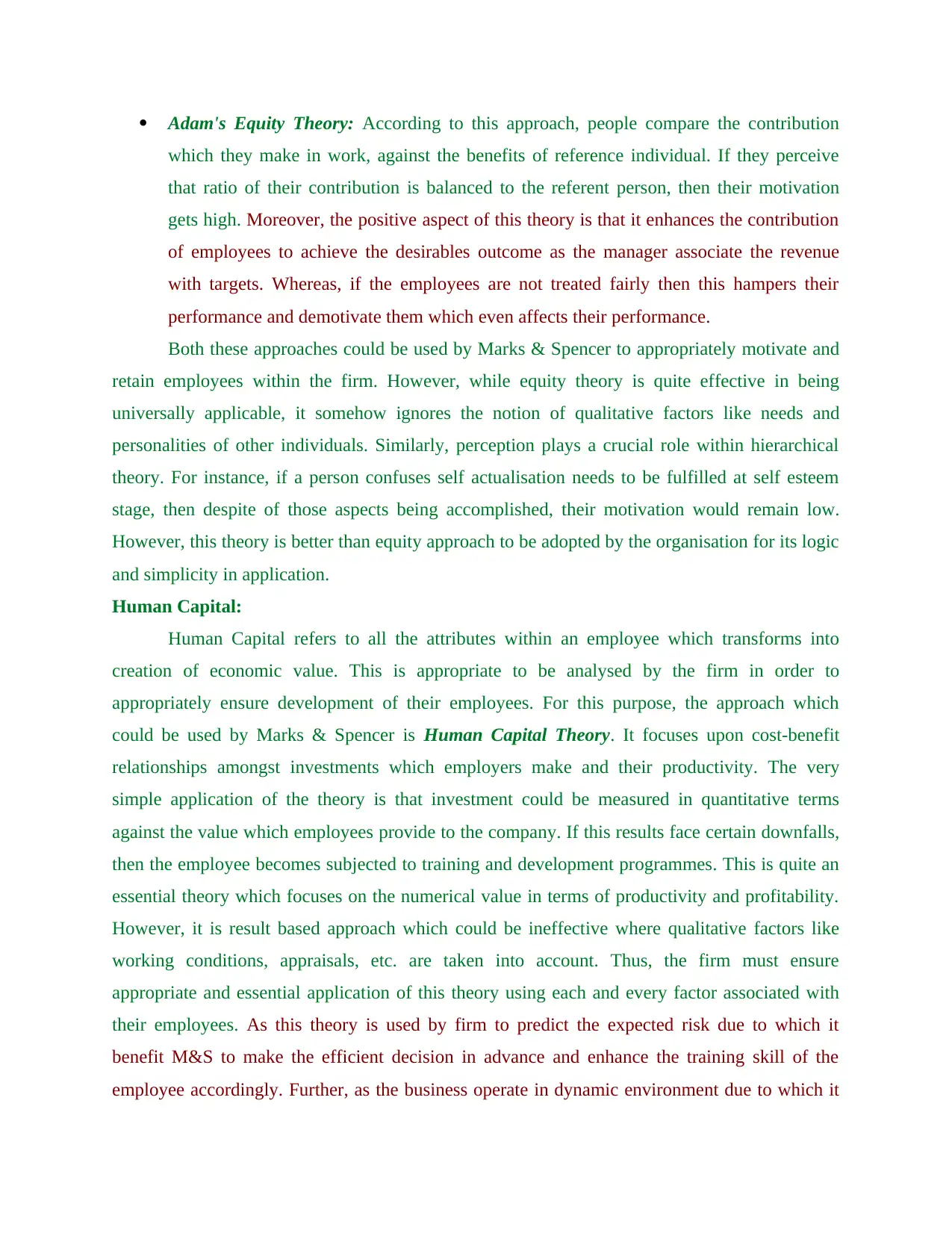
Adam's Equity Theory: According to this approach, people compare the contribution
which they make in work, against the benefits of reference individual. If they perceive
that ratio of their contribution is balanced to the referent person, then their motivation
gets high. Moreover, the positive aspect of this theory is that it enhances the contribution
of employees to achieve the desirables outcome as the manager associate the revenue
with targets. Whereas, if the employees are not treated fairly then this hampers their
performance and demotivate them which even affects their performance.
Both these approaches could be used by Marks & Spencer to appropriately motivate and
retain employees within the firm. However, while equity theory is quite effective in being
universally applicable, it somehow ignores the notion of qualitative factors like needs and
personalities of other individuals. Similarly, perception plays a crucial role within hierarchical
theory. For instance, if a person confuses self actualisation needs to be fulfilled at self esteem
stage, then despite of those aspects being accomplished, their motivation would remain low.
However, this theory is better than equity approach to be adopted by the organisation for its logic
and simplicity in application.
Human Capital:
Human Capital refers to all the attributes within an employee which transforms into
creation of economic value. This is appropriate to be analysed by the firm in order to
appropriately ensure development of their employees. For this purpose, the approach which
could be used by Marks & Spencer is Human Capital Theory. It focuses upon cost-benefit
relationships amongst investments which employers make and their productivity. The very
simple application of the theory is that investment could be measured in quantitative terms
against the value which employees provide to the company. If this results face certain downfalls,
then the employee becomes subjected to training and development programmes. This is quite an
essential theory which focuses on the numerical value in terms of productivity and profitability.
However, it is result based approach which could be ineffective where qualitative factors like
working conditions, appraisals, etc. are taken into account. Thus, the firm must ensure
appropriate and essential application of this theory using each and every factor associated with
their employees. As this theory is used by firm to predict the expected risk due to which it
benefit M&S to make the efficient decision in advance and enhance the training skill of the
employee accordingly. Further, as the business operate in dynamic environment due to which it
which they make in work, against the benefits of reference individual. If they perceive
that ratio of their contribution is balanced to the referent person, then their motivation
gets high. Moreover, the positive aspect of this theory is that it enhances the contribution
of employees to achieve the desirables outcome as the manager associate the revenue
with targets. Whereas, if the employees are not treated fairly then this hampers their
performance and demotivate them which even affects their performance.
Both these approaches could be used by Marks & Spencer to appropriately motivate and
retain employees within the firm. However, while equity theory is quite effective in being
universally applicable, it somehow ignores the notion of qualitative factors like needs and
personalities of other individuals. Similarly, perception plays a crucial role within hierarchical
theory. For instance, if a person confuses self actualisation needs to be fulfilled at self esteem
stage, then despite of those aspects being accomplished, their motivation would remain low.
However, this theory is better than equity approach to be adopted by the organisation for its logic
and simplicity in application.
Human Capital:
Human Capital refers to all the attributes within an employee which transforms into
creation of economic value. This is appropriate to be analysed by the firm in order to
appropriately ensure development of their employees. For this purpose, the approach which
could be used by Marks & Spencer is Human Capital Theory. It focuses upon cost-benefit
relationships amongst investments which employers make and their productivity. The very
simple application of the theory is that investment could be measured in quantitative terms
against the value which employees provide to the company. If this results face certain downfalls,
then the employee becomes subjected to training and development programmes. This is quite an
essential theory which focuses on the numerical value in terms of productivity and profitability.
However, it is result based approach which could be ineffective where qualitative factors like
working conditions, appraisals, etc. are taken into account. Thus, the firm must ensure
appropriate and essential application of this theory using each and every factor associated with
their employees. As this theory is used by firm to predict the expected risk due to which it
benefit M&S to make the efficient decision in advance and enhance the training skill of the
employee accordingly. Further, as the business operate in dynamic environment due to which it
⊘ This is a preview!⊘
Do you want full access?
Subscribe today to unlock all pages.

Trusted by 1+ million students worldwide
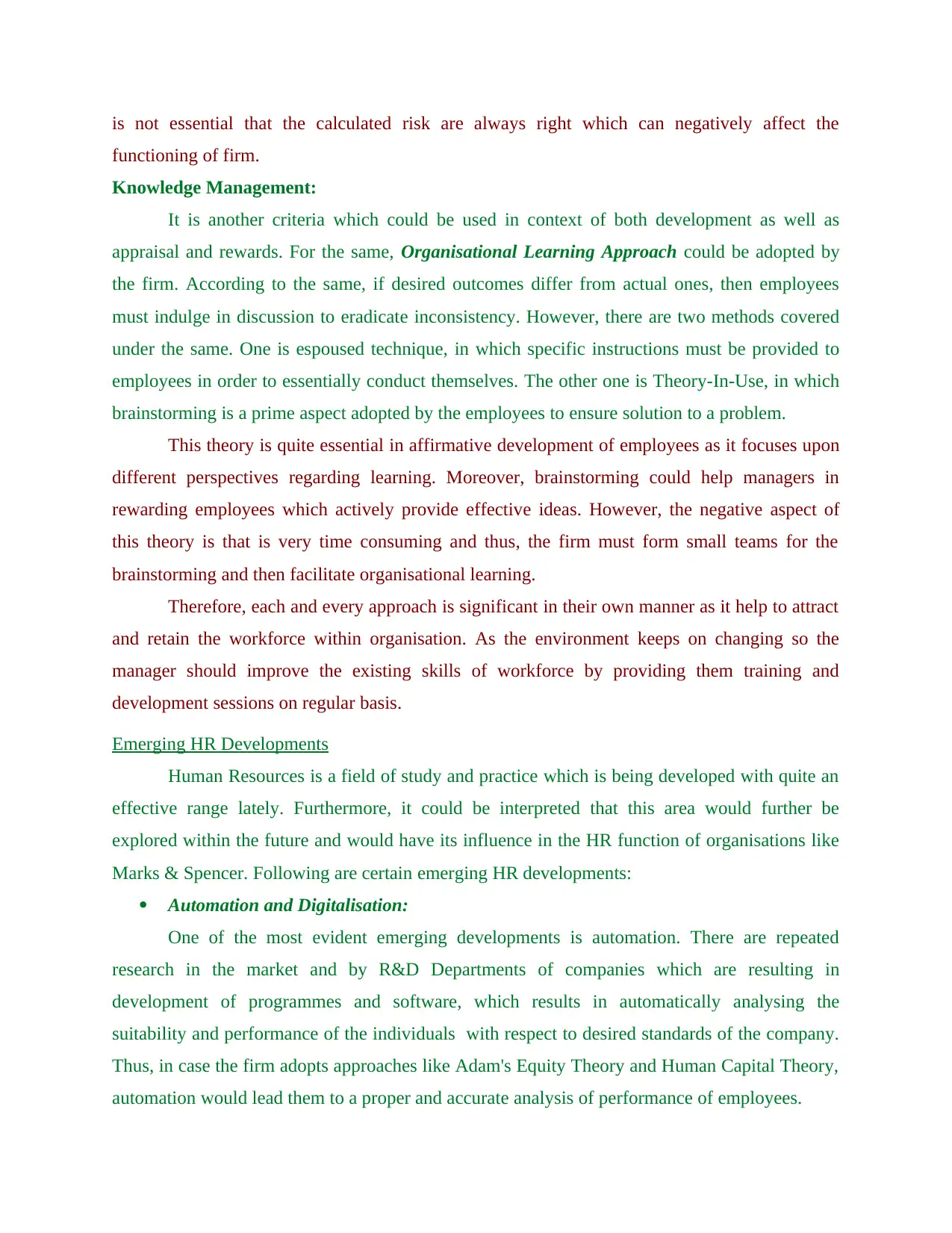
is not essential that the calculated risk are always right which can negatively affect the
functioning of firm.
Knowledge Management:
It is another criteria which could be used in context of both development as well as
appraisal and rewards. For the same, Organisational Learning Approach could be adopted by
the firm. According to the same, if desired outcomes differ from actual ones, then employees
must indulge in discussion to eradicate inconsistency. However, there are two methods covered
under the same. One is espoused technique, in which specific instructions must be provided to
employees in order to essentially conduct themselves. The other one is Theory-In-Use, in which
brainstorming is a prime aspect adopted by the employees to ensure solution to a problem.
This theory is quite essential in affirmative development of employees as it focuses upon
different perspectives regarding learning. Moreover, brainstorming could help managers in
rewarding employees which actively provide effective ideas. However, the negative aspect of
this theory is that is very time consuming and thus, the firm must form small teams for the
brainstorming and then facilitate organisational learning.
Therefore, each and every approach is significant in their own manner as it help to attract
and retain the workforce within organisation. As the environment keeps on changing so the
manager should improve the existing skills of workforce by providing them training and
development sessions on regular basis.
Emerging HR Developments
Human Resources is a field of study and practice which is being developed with quite an
effective range lately. Furthermore, it could be interpreted that this area would further be
explored within the future and would have its influence in the HR function of organisations like
Marks & Spencer. Following are certain emerging HR developments:
Automation and Digitalisation:
One of the most evident emerging developments is automation. There are repeated
research in the market and by R&D Departments of companies which are resulting in
development of programmes and software, which results in automatically analysing the
suitability and performance of the individuals with respect to desired standards of the company.
Thus, in case the firm adopts approaches like Adam's Equity Theory and Human Capital Theory,
automation would lead them to a proper and accurate analysis of performance of employees.
functioning of firm.
Knowledge Management:
It is another criteria which could be used in context of both development as well as
appraisal and rewards. For the same, Organisational Learning Approach could be adopted by
the firm. According to the same, if desired outcomes differ from actual ones, then employees
must indulge in discussion to eradicate inconsistency. However, there are two methods covered
under the same. One is espoused technique, in which specific instructions must be provided to
employees in order to essentially conduct themselves. The other one is Theory-In-Use, in which
brainstorming is a prime aspect adopted by the employees to ensure solution to a problem.
This theory is quite essential in affirmative development of employees as it focuses upon
different perspectives regarding learning. Moreover, brainstorming could help managers in
rewarding employees which actively provide effective ideas. However, the negative aspect of
this theory is that is very time consuming and thus, the firm must form small teams for the
brainstorming and then facilitate organisational learning.
Therefore, each and every approach is significant in their own manner as it help to attract
and retain the workforce within organisation. As the environment keeps on changing so the
manager should improve the existing skills of workforce by providing them training and
development sessions on regular basis.
Emerging HR Developments
Human Resources is a field of study and practice which is being developed with quite an
effective range lately. Furthermore, it could be interpreted that this area would further be
explored within the future and would have its influence in the HR function of organisations like
Marks & Spencer. Following are certain emerging HR developments:
Automation and Digitalisation:
One of the most evident emerging developments is automation. There are repeated
research in the market and by R&D Departments of companies which are resulting in
development of programmes and software, which results in automatically analysing the
suitability and performance of the individuals with respect to desired standards of the company.
Thus, in case the firm adopts approaches like Adam's Equity Theory and Human Capital Theory,
automation would lead them to a proper and accurate analysis of performance of employees.
Paraphrase This Document
Need a fresh take? Get an instant paraphrase of this document with our AI Paraphraser

Learning Management Systems:
Technology has gone far enough to ensure that proper learning is facilitated within the
organisation. Organisational structures internally are adopted several management systems
currently which are linked to providing appropriate knowledge to individuals working in the
company. Thus, this would increase productivity as well as opportunities for employees to grow
and prosper. As far as being responsive is concerned, through this development, Marks &
Spencer could adopt Organisational Learning approach easily.
Skill Assessment:
This development is linked to detailed and effective online tests and assessments related
to judging and analysing a candidate based on their responses. An accurate description would be
productive for the company to segregate important candidates simultaneously, based on their
scores. Marks & Spencer could utilise the same appropriately in attracting new talent and the
same would contribute towards making a diverse and competent workforce.
HR Developments affecting HR functions in Future
All these developments are quite effective in relation to providing companies with ease
and convenience in carrying out their duties for managing human resources appropriately. In
future, these developments would affect HR functions of companies like Marks & Spencer in
numerous ways. First, by automation, there will be non-biased and accurate results, which will
help the firm in training their employees in ways which appropriately ensures their retention and
development. Further, Learning management systems would ensure better development and
organisational learning which is another appropriate function of HR. Moreover, in context with
recruitment and selection, online assessments would ensure shorter time in gaining competent
individuals within the company which fit the criteria of the firm.
Hence, the defined emerging HR developments which is digitalisation, skill assessment
and learning assessment are the significant HR functions that can help M&S to remain
competitive. This widen the growth opportunity for both employees and organisation which
finally lower down the turnover rate of company.
Conclusion and recommendation
From the above part it has been concluded that organisation design as well as structure
differ from one to another based on the size and chain of command. HR manager should build
HR Practices effectively so that it can take the organisation in desired direction. Moreover, HR
Technology has gone far enough to ensure that proper learning is facilitated within the
organisation. Organisational structures internally are adopted several management systems
currently which are linked to providing appropriate knowledge to individuals working in the
company. Thus, this would increase productivity as well as opportunities for employees to grow
and prosper. As far as being responsive is concerned, through this development, Marks &
Spencer could adopt Organisational Learning approach easily.
Skill Assessment:
This development is linked to detailed and effective online tests and assessments related
to judging and analysing a candidate based on their responses. An accurate description would be
productive for the company to segregate important candidates simultaneously, based on their
scores. Marks & Spencer could utilise the same appropriately in attracting new talent and the
same would contribute towards making a diverse and competent workforce.
HR Developments affecting HR functions in Future
All these developments are quite effective in relation to providing companies with ease
and convenience in carrying out their duties for managing human resources appropriately. In
future, these developments would affect HR functions of companies like Marks & Spencer in
numerous ways. First, by automation, there will be non-biased and accurate results, which will
help the firm in training their employees in ways which appropriately ensures their retention and
development. Further, Learning management systems would ensure better development and
organisational learning which is another appropriate function of HR. Moreover, in context with
recruitment and selection, online assessments would ensure shorter time in gaining competent
individuals within the company which fit the criteria of the firm.
Hence, the defined emerging HR developments which is digitalisation, skill assessment
and learning assessment are the significant HR functions that can help M&S to remain
competitive. This widen the growth opportunity for both employees and organisation which
finally lower down the turnover rate of company.
Conclusion and recommendation
From the above part it has been concluded that organisation design as well as structure
differ from one to another based on the size and chain of command. HR manager should build
HR Practices effectively so that it can take the organisation in desired direction. Moreover, HR
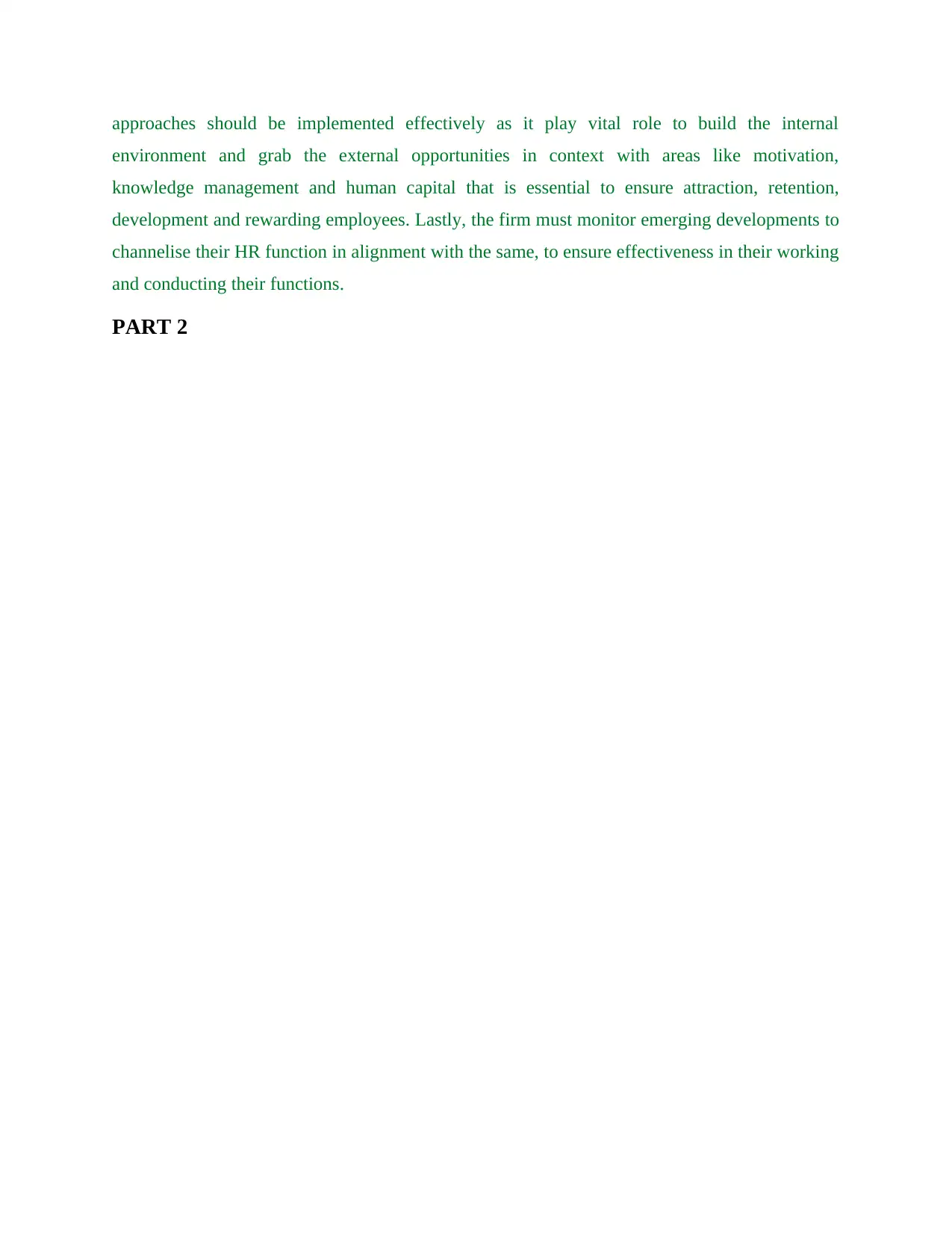
approaches should be implemented effectively as it play vital role to build the internal
environment and grab the external opportunities in context with areas like motivation,
knowledge management and human capital that is essential to ensure attraction, retention,
development and rewarding employees. Lastly, the firm must monitor emerging developments to
channelise their HR function in alignment with the same, to ensure effectiveness in their working
and conducting their functions.
PART 2
environment and grab the external opportunities in context with areas like motivation,
knowledge management and human capital that is essential to ensure attraction, retention,
development and rewarding employees. Lastly, the firm must monitor emerging developments to
channelise their HR function in alignment with the same, to ensure effectiveness in their working
and conducting their functions.
PART 2
⊘ This is a preview!⊘
Do you want full access?
Subscribe today to unlock all pages.

Trusted by 1+ million students worldwide
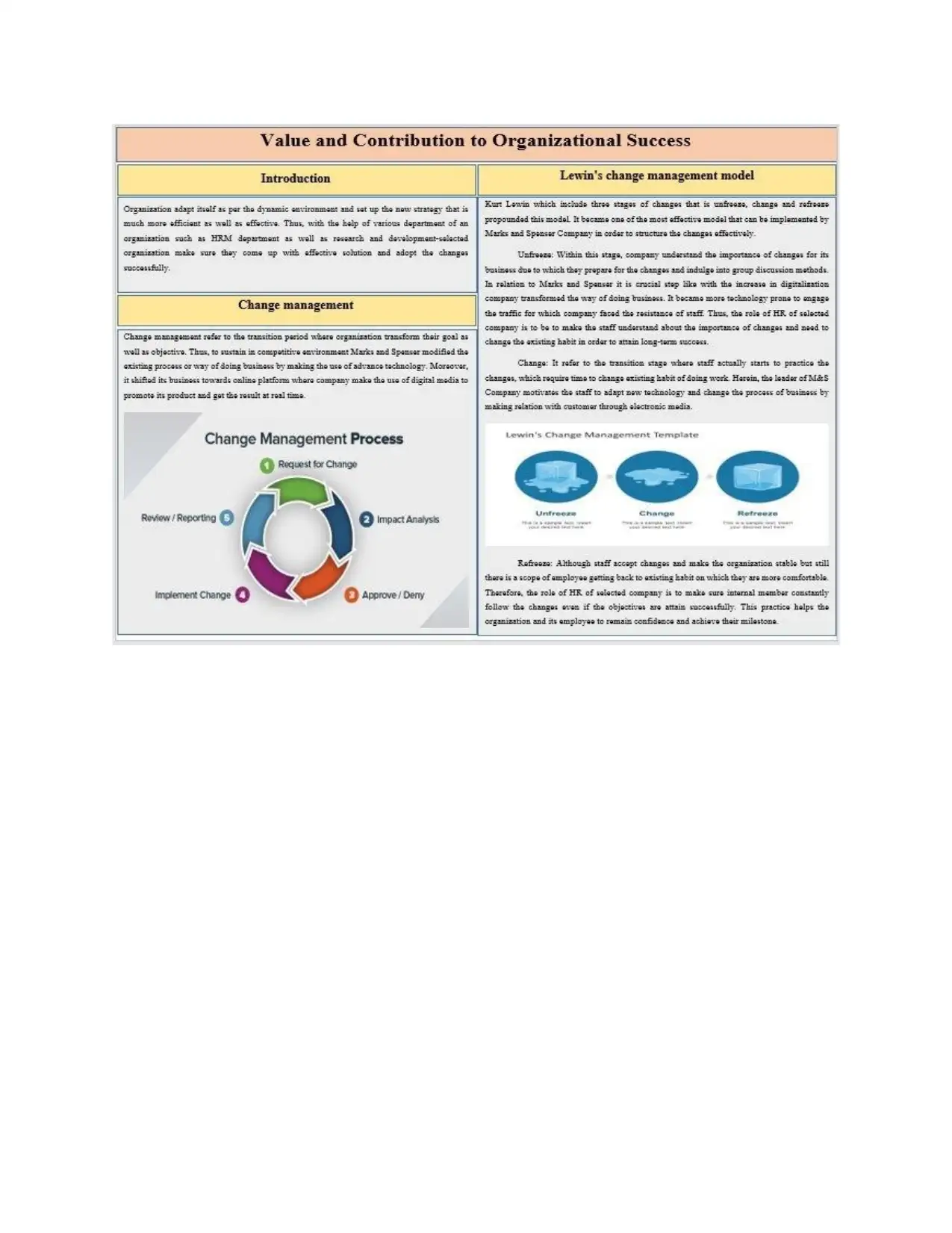
Paraphrase This Document
Need a fresh take? Get an instant paraphrase of this document with our AI Paraphraser
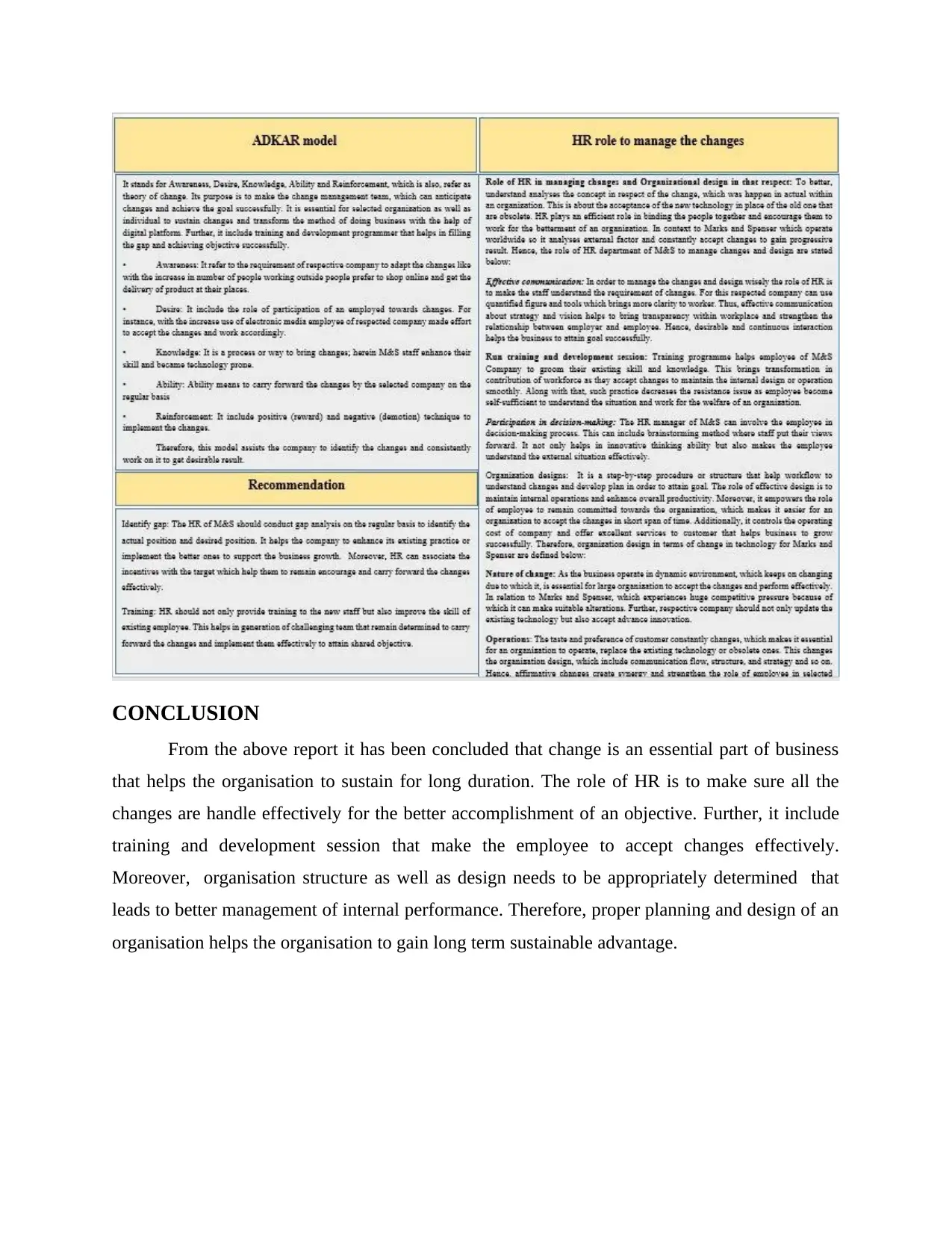
CONCLUSION
From the above report it has been concluded that change is an essential part of business
that helps the organisation to sustain for long duration. The role of HR is to make sure all the
changes are handle effectively for the better accomplishment of an objective. Further, it include
training and development session that make the employee to accept changes effectively.
Moreover, organisation structure as well as design needs to be appropriately determined that
leads to better management of internal performance. Therefore, proper planning and design of an
organisation helps the organisation to gain long term sustainable advantage.
From the above report it has been concluded that change is an essential part of business
that helps the organisation to sustain for long duration. The role of HR is to make sure all the
changes are handle effectively for the better accomplishment of an objective. Further, it include
training and development session that make the employee to accept changes effectively.
Moreover, organisation structure as well as design needs to be appropriately determined that
leads to better management of internal performance. Therefore, proper planning and design of an
organisation helps the organisation to gain long term sustainable advantage.

⊘ This is a preview!⊘
Do you want full access?
Subscribe today to unlock all pages.

Trusted by 1+ million students worldwide
1 out of 13
Related Documents
Your All-in-One AI-Powered Toolkit for Academic Success.
+13062052269
info@desklib.com
Available 24*7 on WhatsApp / Email
![[object Object]](/_next/static/media/star-bottom.7253800d.svg)
Unlock your academic potential
Copyright © 2020–2025 A2Z Services. All Rights Reserved. Developed and managed by ZUCOL.





